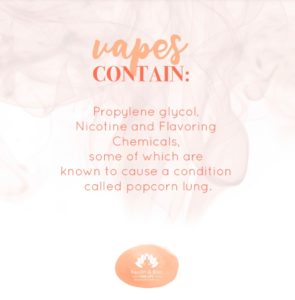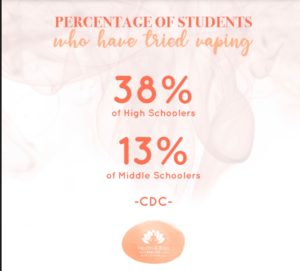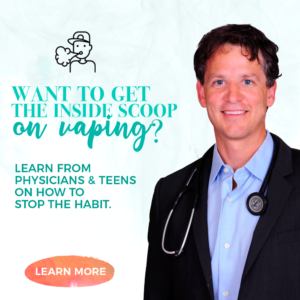
I was sitting in an upscale restaurant, celebrating my nephew’s 20th birthday. We are the old folks here. I get it. Half a dozen dapper college kids surrounded the table, laughing and eating, and vaping. The coy device, placed in the palm of their hand, is raised to their mouth with a vogue sense of style. They innocently think vaping is harmless. That’s the problem. It’s like watching a train wreck, really. Watching history repeat itself. Remember all the bright stars of the ’50s who suffered from lung cancer and died – usually before the age of 60? The FDA commissioner, Dr. Scott Gottllieb, warned: “We simply cannot allow a whole new generation to become addicted to nicotine.”
Vaping is the act of inhaling vapor created from a liquid that is heated up inside a battery-operated device — an electronic cigarette or vape pen. The metal coils that heat up the fluid inside e-cigarettes can cause trace chemicals in the liquid to become toxic, even carcinogenic. It’s marketed as a safe alternative to smoking. It is not. Most vape liquids contain a combination of propylene glycol, glycerol as a base, nicotine and chemicals to produce flavors such as bubble gum, gummy bear or unicorn crunch (whom are we marketing to here, anyway?) But e-cigarettes, or vapes, can also vaporize other substances, including marijuana.
What are the Dangers of Vaping?
Let’s start with the most obvious organ at risk, the lungs. According to the American Lung Association, using electronic cigarettes, particularly the flavored varieties, can cause popcorn lung. Popcorn lung is a condition that damages your lungs and its smallest airways, making you cough and feel short of breath. Popcorn lung was coined to describe a condition found in employees who were packaging microwave popcorn. The chemical that caused the condition is known as diacetyl and was discovered in 2000. The same chemical is included in the majority of e-cigarettes. 1
A study in 2015 of flavored e-cigarettes found that 39 out of 51 brands tested contained diacetyl. Available flavors ranged from vanilla to coconut. 2
Researchers also found that macrophages (immune cells found in lung tissue) had an increase in the inflammatory response from e-cigarettes with or without nicotine. They also found the vapor disabled the ability of the macrophages to engulf bacteria and protect pulmonary function. This damage increases the cells’ vulnerability to dust, bacteria and allergens, increasing the risk of triggering COPD (chronic obstructive pulmonary disease). 3
Vaping exposes young brains to nicotine. The JUULpod, a popular vaping device, contains 40 mg of nicotine, which is similar to the nicotine yield of a pack of cigarettes. The adolescent brain (before the age of 25) is more vulnerable to addiction. Addictive tendencies and withdrawal symptoms are often present after just one or two exposures. Early exposure to nicotine during the transition from child to adult may be harmful, since it may interrupt the normal course of brain maturation and have lasting consequences on cognitive ability, mental health, and even personality (Brown et al. 1996; Choi et al. 1997; Richards et al. 2003; Brook et al. 2004; Deas 2006).
Professor Suchitr Krishnan-Sarin from the Department of Psychiatry at Yale University said she is concerned that most teens who vape with nicotine are not aware that the drug can be damaging to their development. “We have a lot of evidence showing that the adolescent brain is extremely sensitive to the effects of nicotine. Studies have shown us that nicotine can interfere with memory and attention processing,” said Krishnan-Sarin.
Nicotine in the lungs, according to Vardavas et al, is thought to increase airway resistance and impedance. Nonsmokers who inhaled nicotine (0-64mg/ml) showed a dose-dependent increase in both the amount of coughing and airway obstruction, suggesting that nicotine stimulates afferent nerve endings in the bronchial mucosa which then triggers parasympathetic cholinergic pathways leading to bronchoconstriction. 10
What is in Vaping Devices
Propylene glycol – a lab-made liquid that the FDA views as safe in food, drugs and cosmetics. It can irritate the lungs and be harmful for those with COPD.
Glycerin: Oder-less liquid with a sweet taste. FDA views as safe.
Nicotine: a stimulant and potent parasympathetic alkaloid. Known to be addictive and interfere with memory and mental processing in adolescents.
Toxic chemicals are formed as the e-liquid heats up to make aerosol that is inhaled. Some of these chemicals can cause inflammation according to Dr. Benowitz at San Francisco’s school of Medicine. These chemicals include:
Formaldehyde: A probable carcinogen
Acetaldehyde: A probable carcinogen
Acrolein: Formed from heated glycerin, acrolein can damage the lungs and contribute to heart disease in smokers.
Diacetyl: Causes popcorn lung, a condition that damages your lungs and its smallest airways.
The chemical content increases as the temperature from the vape increases. Flavors make it easier to mask the bad taste that results from high temperatures and more damaging chemical exposure. Toxic metals such as tin, nickel, cadmium, lead and mercury have all been found in e-cigarette aerosol.11

Chances of vaping affecting your teen
According to the Centers for Disease Control, 38% of high schoolers and 13% of middle schoolers have tried vaping at least once; 20.9% report regular vaping.12 (Still wonder if this is an epidemic?) These are self-reported statistics lending us to believe the numbers are likely much higher. This is not a surprise since seven in 10 high schoolers report being exposed to ads for vaping. Of the youth who start vaping, 30.7% will move on to smoking within six months. Now seems like a good time to remember that smoking is the leading cause of preventable death in the United States. So while we are looking out for the health of our families, vaping companies are invading the minds of our youth, deeming this as a harmless, innocent habit. Two-thirds, or 66%, of teens vaping report that the vapes contain “just flavoring.”
If we aren’t upset by this trend yet, we should be. Vaping is a habit that will undoubtedly impact the long-term health and vitality of its users.

Is vaping, as an alternative to smoking, safe or safer?
Vaping has been marketed as a safe alternative to smoking. The danger in that message is that its users interpret this as having then been deemed safe. The list of known carcinogens with tobacco smoke are well over 60. The known carcinogens in vaping are reportedly much fewer. But vaping products are not created equally. The variety of chemicals in the vaping devices is endless and largely unregulated. If you placed me in a locked room and forced me to either vape or smoke, I would most likely choose the vaping device. If you gave me the option of vaping or fresh air – I would undoubtedly choose fresh air.
The American Lung Association, the FDA and the U.S. Surgeon General are all issuing strong warnings about the dangers of vaping. The vaping industry is creating stuff that we don’t fully understand, but can logically deduce can pose long-term health concerns.
Talking to your Kids
Addiction is a hard thing to explain. Letting your teen know that when you get addicted to a substance, it’s like losing your freedom. You are controlled by your body’s need for the substance and withdrawal is not only emotional, but physical. Allow your kids to read the facts and empower them to make a positive choice for their own health. Immediate consequences to vaping can include, decreased athletic performance, increased coughing and wheezing, addiction and impaired brain development. Share with them the long-term impact of lung disease. Show them pictures and videos of individuals with chronic obstructive pulmonary disease. Youth oftentime feel indestructible; these images can be very sobering. Attached is the U.S. Surgeon General’s fact sheet on vaping.
For parents interested in stopping lifetime addictions, we have a great resource for you — a video series aimed to raise awareness about this trend that is impacting one in four teens. This course was made by teens and physicians interested in making a difference in their community. It shows parents the “hot spots” where kids easily hide vaping devices. Disguised as USB ports and flash drives as well as other devious designs, companies make devices intentionally difficult to spot for the unsuspecting parent.3 things you will learn in this course are: 1. How to properly identify a vaping device. 2. Hot spots around the house where teens hide vapes. 3. How to talk in depth with your teen about vaping. This is a must-have course for parents who have preteens or teens. Proceeds from the course will go to continuing efforts to raise awareness and empower parents to raise thriving and healthy adults.
References
1 https://www.lung.org/about-us/blog/2016/07/popcorn-lung-risk-ecigs.html
2 https://ehp.niehs.nih.gov/doi/10.1289/ehp.1510185
3 https://e-cigarettes.surgeongeneral.gov/documents/2016_SGR_Full_Report_non-508.pdf,
4 Science Daily, August 13, 2018
9 Deas 2006.
10 Vardavas CI, Anagnostopoulos N, Kougias M, Evangelopoulou V, Connolly GN, Behrakis PK. Short-term pulmonary effects of using an electronic cigarette: impact on respiratory flow resistance, impedance, and exhaled nitric oxide. Chest (2012) 141:1400–6. doi:10.1378/chest.11-2443
11https://www.webmd.com/smoking-cessation/news/20150218/e-cigarette-ingredients
12 New England Journal of Medicine, Adolescent vaping and Nicotine Use in 2017-2018 – U.S. National Estimates https://www.nejm.org/doi/full/10.1056/NEJMc1814130



